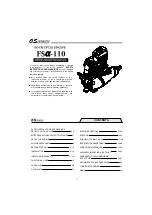
Page 4
For technical questions, please call 1-888-866-5797.
ITEM 60363
SAFETY
Op
ERA
TION
M
AINTENANCE
SETU
p
Set up precautions
1. Gasoline fuel and fumes are flammable, and
potentially explosive. Use proper fuel storage
and handling procedures. Do not store fuel
or other flammable materials nearby.
2. Have multiple ABC class fire extinguishers nearby.
3. Operation of this equipment may create sparks
that can start fires around dry vegetation. A spark
arrestor may be required. The operator should
contact local fire agencies for laws or regulations
relating to fire prevention requirements.
4. Set up and use only on a flat, level,
well-ventilated surface.
5. Wear ANSI-approved safety goggles, heavy-duty
work gloves, and dust mask/respirator during set up.
6. Use only lubricants and fuel recommended
in the Specifications chart of this manual.
Operating precautions
1.
CARBON MONOXIDE HAZARD
Using an engine indoors CAN KILL
YOU IN MINUTES.
Engine exhaust contains carbon
monoxide. This is a poison you cannot
see or smell.
NEVER use inside a home or garage,
EVEN IF doors and windows are open.
Only use OUTSIDE and far away from windows,
doors, and vents.
2. Keep children away from the equipment,
especially while it is operating.
3. Keep all spectators at least six feet
from the Engine during operation.
4. Fire Hazard! Do not fill gas tank while engine is
running. Do not operate if gasoline has been spilled.
Clean spilled gasoline before starting engine.
Do not operate near pilot light or open flame.
5. Do not touch engine during use.
Let engine cool down after use.
6. Never store fuel or other flammable
materials near the engine.
7. Only use a suitable means of transport and
lifting devices with sufficient weight bearing
capacity when transporting the Engine.
8. Secure the Engine on transport vehicles to
prevent the tool from rolling, slipping, and tilting.
9. Industrial applications must follow
OSHA requirements.
10. Do not leave the equipment unattended when it is
running. Turn off the equipment (and remove safety
keys, if available) before leaving the work area.
11. Engine can produce high noise levels.
Prolonged exposure to noise levels
above 85 dBA is hazardous to hearing.
Always wear ear protection when operating or
working around the gas engine while it is operating.
12. Wear ANSI-approved safety glasses, hearing
protection, and NIOSH-approved dust mask/
respirator under a full face shield along
with steel-toed work boots during use.
13. People with pacemakers should consult their
physician(s) before use. Electromagnetic fields in
close proximity to a heart pacemaker could cause
pacemaker interference or pacemaker failure.
Caution is necessary when near the
engine’s magneto or recoil starter.
14. Use only accessories that are recommended
by Harbor Freight Tools for your model.
Accessories that may be suitable for one
piece of equipment may become hazardous
when used on another piece of equipment.
15. Do not operate in explosive atmospheres,
such as in the presence of flammable
liquids, gases, or dust. Gasoline-powered
engines may ignite the dust or fumes.
16. Stay alert, watch what you are doing and
use common sense when operating this
piece of equipment. Do not use this piece of
equipment while tired or under the influence
of drugs, alcohol or medication.
17. Do not overreach. Keep proper footing and
balance at all times. This enables better control
of the equipment in unexpected situations.
18. Use this equipment with both hands
only. Using equipment with only one hand
can easily result in loss of control.
19. Dress properly. Do not wear loose clothing or
jewelry. Keep hair, clothing and gloves away
from moving parts. Loose clothes, jewelry or
long hair can be caught in moving parts.





































